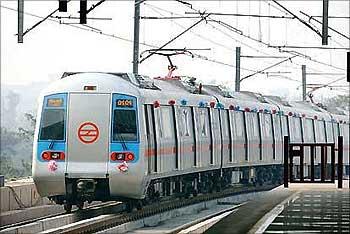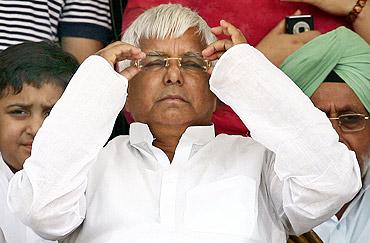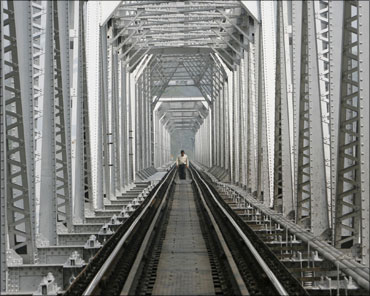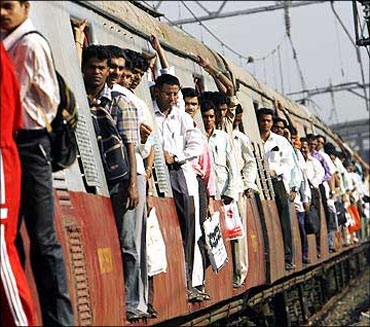Sudheer Pal Singh in New Delhi
For Indian Railways, performance parameters have always been wrapped up in supposed magic.
Lalu Prasad, who became the railway minister in May 2004, surprised the world in 2008 with the 'magic' turnaround he effected for the near-bankrupt railways, claiming to have created a surplus of Rs 25,000 crore (Rs 250 billion.
It was equal magic when Mamata Banerjee, the previous railway minister, announced in her budget speech earlier this year that she managed to bring down the operating ratio, a performance indicator, during the last financial year.
. . .
New rail minister won't hike fare for turnaround
Image: The Metro Rail of Kolkata.This was despite a Rs 4,000-crore (Rs 40-billion) loss on account of a drop in iron ore loading and the Gujjar agitation coupled with a Rs 15,000-crore (Rs 150-billion) outgo on account of pay commission recommendations.
Continuing with the legacy, new railway minister Dinesh Trivedi, while taking charge earlier this week, promised magic again -- a turnaround without raising passenger fares.
"Increasing passenger fares is the easiest thing to do for improving finances.
"But we have to see whether there are alternative measures," Trivedi said. Indian Railways' losses from passenger operation are about Rs 14,000 crore (Rs 140 billion), around 15 per cent of its overall annual earnings of Rs 94,800 crore (Rs 948 billion).
. . .
New rail minister won't hike fare for turnaround
Experts believe an increase in passenger fares, frozen for the past eight years, should form an important aspect of railways' strategy to improve its financial health.
"For example, the potential for a hike exists in the lower-class passenger segment, owing to the huge passenger volumes it contributes.
"By raising the quality of service to this segment, and increasing its fares marginally in return, railways could generate income which might not appear huge but could aid in ramping up revenues," says Tarun Kumar Gupta, senior manager, PricewaterhouseCoopers.
"In any case, a hike in passenger fares has become inevitable now."
. . .
New rail minister won't hike fare for turnaround
Image: Lalu Prasad.The lower-class unreserved segment -- generally called second class (ordinary) -- accounted for 83 per cent of the railways' overall passenger volume and contributed 23 per cent of the total passenger revenue of Rs 26,126 crore (Rs 261.26 billion) in the last financial year.
| CHUGGING ON | ||||
|
| Volume | % of total | Revenue | %of total |
| Lower Class* | 6,439 | 83 | 5988.00 | 23.00 |
| Upper Class# | 1,392 | 17 | 20138.00 | 77 |
| Volume in million; Revenue in Rs crore * includes Second Class (Ordinary); | ||||
| * Passenger revenue has remained around 27 per cent of the total revenue over the past 3 years even as passenger fares have not been hiked | ||||
| * Passenger volumes have jumped 10 per cent from 7,046 million in 2008-09 to 7,773 million in 2010-11 | ||||
. . .
New rail minister won't hike fare for turnaround
Even a 10 per cent increase in lower class fares would lead to a mere Rs 3 increase in the cost of a ticket for a 100-kilometre journey.
But it would generate an additional Rs 600 crore (Rs 6 billion) for railways annually, 27 per cent of its annual expenditure of Rs 2,200 crore (Rs 22 billion) on doubling of lines.
In 2005, when Lalu Prasad was the minister, there was a plan to increase the number of lower-class coaches substantially.
. . .
New rail minister won't hike fare for turnaround
The idea failed to see the light of the day, though a senior official said the number of these coaches had doubled to four in a train of 24 coaches.
On an average, 300 people travel in an unreserved compartment as compared to 70 passengers in the reserved category.
Travelling experience for these 300 passengers is marked by lack of proper sanitation facilities, aeration, comfortable seating and a humiliating absence of personal space.
Over the years, railways have failed to capitalise on the huge demand that exists in the unreserved segment, experts point out.








article